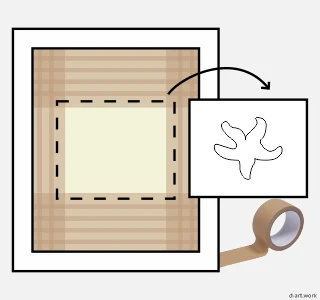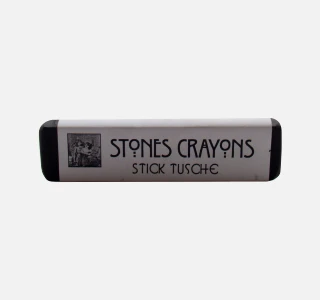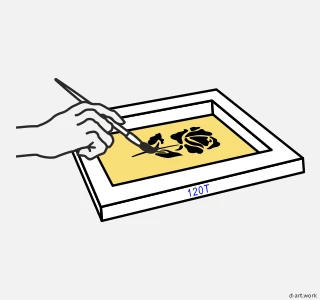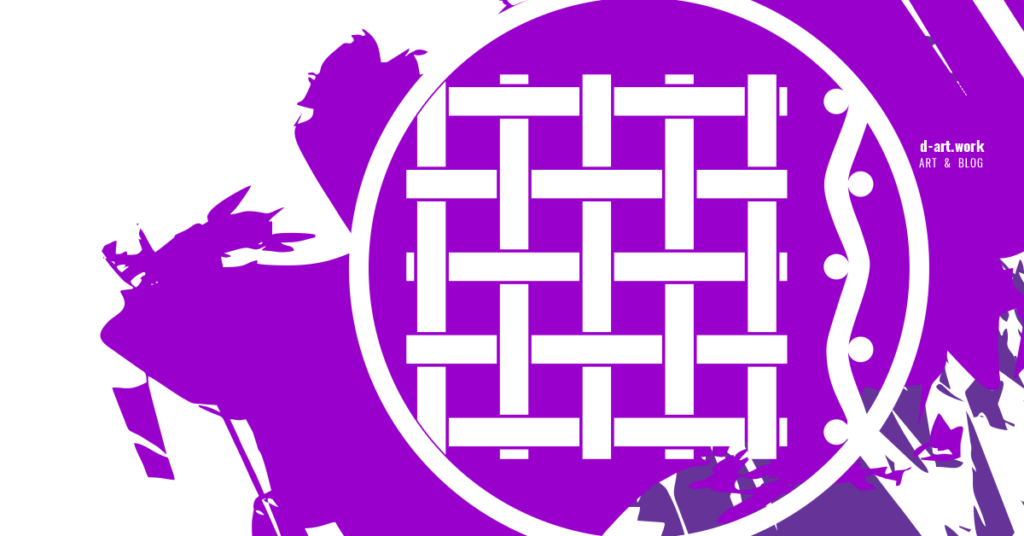This article covers three totally different ways of producing a silkscreen stencil, each dependent on the type of production, such as quantity or substrate, but also dependent on the resources or intentions of the user, who may not have the most suitable place or budget and may also want a more intimist or handmade experience.
Printscreen Matrix or Silkscreen Stencil
The stencil is the equivalent of a mold, a way to reproduce the same exact image without having to draw or paint it over and over again.
In the context of silkscreen printing, the stencil means the screen itself after engraving the matrix to be printed (in industry jargon, this process is also called frame opening). For this purpose, there are three ways of producing the silkscreen stencil:
1. Cutout
2. Photosensitization
3. Tousche-and-Glue

1. Hand-cut stencil
This is the oldest silkscreen stencil process, which in this context consists of cutting or casting a shape out of paper or thin material and applying it directly to the substrate or to the screen, covering the unprintable areas of it using a blocker – water resistant glue, lacquer or tape. This process is the easiest, fastest, most straightforward and environmentally friendly, but only viable for flat images without details. Images with details can still be cut out on a cutting plotter, but the image will still be opaque, without the possibility of halftones.


2. Photosensitization
This is a chemical process of developing the silkscreen stencil by means of a light-sensitive emulsion rich in ultra violet rays. This type of stencil is in turn divided into three types of process – direct, indirect or mixed.
The indirect process consists in the use of a pre-sensitized, dry film, commonly called capillary film (because it is supplied in a tube), a sheet of transparent film that has one side coated with sensitized emulsion and another side of adhesive film that will be removed at the end of the process. To this pre-sensitized sheet is added another transparent film where the desired image is drawn or printed, in black and opaque form, which is called slide (if drawn by hand) or photolyte (if printed mechanically). The slide pressed to the transparent face of the sensitized film is then exposed to ultra violet light for a few minutes. The light passes through the transparent films and penetrates the emulsified side not protected by the opacity of the image drawn on the slide. The emulsified parts affected by the light solidify to an insoluble form through chemical reaction. The slide is then removed and the sensitized film is washed away so that the parts not covered by light are diluted in water to reveal the printed design.
Depending on the type of film used, this washing should be done with water at a temperature between 21ºC and 41ºC until the image is clearly revealed, and a short period of cold water to fix the image. Still taking advantage of the humidity from the washing, the film is applied to the face of the screen that contacts the substrate and allowed to dry. After drying, the aforementioned transparent film opposite the emulsified face is removed, and the entire remaining area of the screen is blocked off using blocking liquid, waterproof glue, or adhesive tape.
The direct process does not use pre-sensitized film, only the photolith or photolyte of the image to be printed and liquid emulsion applied directly to the two sides of the screen using an applicator or the squeegee. After application, this emulsion is left to dry in a dark room. The photolith is then placed on the screen and pressed against a transparent surface (usually glass). This is followed by exposure to ultraviolet light to etch the matrix onto the screen. Again, the chemical reaction between the light and the emulsion solidifies the holes in the screen that are covered and not covered by the photolith image. The screen is then washed with cold or warm water to dissolve the emulsion in the unlit image spaces. Once dry, the screen is ready for printing.
The direct process also includes another variant, which has emerged more recently, in which the photolith is joined to the screen after application of the emulsion while the canvas is still wet, and drying and developing are joined in a single process when exposed to light. However, this process requires a specific type of film for the photolith, while the previous direct process allows for various types of transparency in imitation of photolyte film (tracing paper or engineering paper, polyester film or acetate).
The mixed process involves a little of each of the previous processes, a sheet of non-sensitized film is applied to the side of the screen facing the substrate and liquid emulsion is spread on the opposite side. After the emulsion dries, the protective film is removed and the stencil is developed by exposure to light, similar to the direct process. The stencil process by photosensitization, whether direct, indirect or mixed, is the only one capable of producing any type of image, including the CMYK process (photographic reproduction).


|
|
|
3. Tousche-and-Glue
This is a silkscreen stencil method drawn by hand directly on the screen. Tousche, tushe or tusch refers to a base or ink of the same nature as lithographic ink, in this case a kind of dark wax generally sold in small sticks or bars, with which the matrix is drawn directly on one side of the screen. The other side of the mesh is then completely covered with waterproof glue and the wax is then diluted by brushing it with turpentine or thinner, thus opening the holes in the mesh corresponding to the image to be printed. In this third process, we can also include the method of drawing directly on the screen using a simple graphite pencil instead of the tousche and blocking the canvas with the glue, brushing it around the drawn outlines, using various thicknesses of brush for the sometimes narrower, sometimes wider areas, depending on the complexity of the drawn figure. These methods are only used by artists.



Find references and more knowledge in Learning Links

